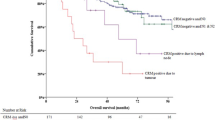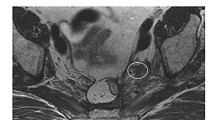Abstract
Background: There has been recent interest in the use of local excision for rectal cancer under consideration of patient's quality of life. However, local excision of the primary tumor does not remove the areas of lymphatic spread. Therefore, the decision to use this procedure must be considered carefully.
Methods: The authors retrospectively analyzed 142 patients who underwent radical resection of rectal cancer without lymph node metastasis in order to define the risk factors for recurrence. The macroscopic and microscopic pathological characteristics, immunohistochemical staining for p53, and DNA ploidy pattern of the primary tumor were examined as potential predictors of recurrence.
Results: The rates for 5-year disease-free survival, local control, freedom from distant metastasis, and overall survival in these 142 patients were 87%, 93%, 93%, and 91%, respectively. Factors related to recurrence and prognosis included the depth of tumor invasion, vascular/lymphatic involvement, tumor differentiation, and tumor size. However, p53 staining and DNA ploidy pattern were not useful indicators.
Conclusions: Our findings suggest that adjunctive radiotherapy and chemotherapy should be considered for patients who have rectal cancer without lymph node metastasis in the following situations: tumor invasion of the serosa, vascular/lymphatic involvement, moderately differentiated adenocarcinoma, and lesions >2 cm in diameter. Local excision should not be used in these situations, even if there are no lymph node metastases.
Similar content being viewed by others
References
Hojo K. Anastomotic recurrence after sphincter-saving resection for rectal cancer.Dis Colon Rectum 1986;29:11–14.
Pollet WG, Nicholls RJ. The relationship between the extent of distal clearance and survival and local recurrence rates after curative anterior resection for carcinoma of the rectum.Ann Surg 1983;198:159–63.
Hojo K, Sawada T, Moriya Y. An analysis of survival and voiding, sexual function after wide iliopelvic lymphadenectomy in patients with carcinoma of the rectum, compared with conventional lymphadenectomy.Dis Colon Rectum 1989;32:128–33.
Ziv Y, Ben-Baruch D, Waizer A, Flex D, Wolloch Y. Local recurrence after low anterior resection using the EEA stapling device.Dis Colon Rectum 1988;31:945–7.
Vlasak JW, Wagner D, Passaro E, Wilson S. Local recurrence after curative resection of rectal cancer: a comparison of low anterior resection and abdominoperineal resection.J Surg Oncol 1989;41:236–9.
Colombo P, Foglieni CLS, Morone C. Analysis of recurrence following curative low anterior resection and stapled anastomoses for carcinoma of the middle third and lower rectum.Dis Colon Rectum 1987;30:457–64.
Graaf PW, Roussel JG, Gorizak E, Hart GAM, Jongman A, Van Slooten E. Early-stage rectal cancer: electrofulguration in comparison to abdominoperineal extirpation or low-anterior resection.J Surg Oncol 1985;29:123–8.
Madden JL, Kandalaft S. Electrocoagulation as a primary curative method in the treatment of carcinoma of the rectum.Surg Gynecol Obstet 1984;157:164–79.
Brodsky JT, Richard G, Cohen AM, Minsky BD. Variables correlated with the risk of lymph node metastasis in early rectal cancer.Cancer 1992;69:322–6.
Graham RA, Gamsey L, Jessup JM. Local excision of rectal carcinoma.Am J Surg 1990;160:306–12.
Biggers OR, Beart RW, Ilstrup DM. Local excision of rectal cancer.Dis Colon Rectum 1986;29:374–7.
Hager T, Gall FP, Hermanek P. Local excision of cancer of the rectum.Dis Colon Rectum 1983;26:149–51.
Baily HR, Huval W, Max E, Smith KW, Butts DR, Zamora LF. Local excision of carcinoma of the rectum for cure.Surgery 1992;111:555–61.
Hojo K, Vernava AM III, Sugihara K, Katsumata K. Preservation of urine voiding and sexual function after rectal cancer surgery.Dis Colon Rectum 1991;34:532–9.
Willett C, Lewandrowski K, Donnelly S, Shellito PC, Convery K, Eliseo R, Compton CC. Are there patients with stage I rectal carcinoma at risk for failure after abdominoperineal resection?Cancer 1992;69:1651–5.
Dukes CE, Bussey HJR. The spread of rectal cancer and its effect on prognosis.Br J Cancer 1958;12:309–20.
Kaplan EL, Meier P. Nonparametric estimation for incomplete observations.J Am Stat Assoc 1958;53:457–81.
Colton T.Statistics in medicine. Boston, MA: Little Brown, 1974.
Banks L, Matelashewski G, Crawford L. Isolation of human-p53 specific monoclonal antibodies and their use in the studies of human p53 expression.Eur J Biochem 1986;159:529–31.
Hedrey D, Friedlander M, Taylor I. Application of DNA flow cytometry to paraffin-embedded archival material for the study of aneuploidy and its clinical significance.Cytometry 1985;6:327–33.
Stearns MW, Sternberg SS, DeCosse JJ. Treatment alternatives: localized rectal cancer.Br J Surg 1985;72:694–7.
Minsky BD, Rich T, Recht A, Harvey W, Miles C. Selection criteria for local excision with or without adjuvant radiation therapy for rectal cancer.Cancer 1989;63:1421–9.
Rosenthal SA, Yeung RS, Weese JL, Eisenberg BL, Hoffman JP, Coia LR, Hanks GE. Conservative management of extensive low-lying rectal carcinomas with transanal local excision and combined preoperative and postoperative radiation therapy.Cancer 1992;69:335–41.
Pahlman L, Glimelius B, Graffman S. Pre- versus postoperative radiotherapy in rectal carcinoma: an interim report from a randomized multicentre trial.Br J Surg 1985;72:961–6.
Minsky BD, Kemeny N, Cohen AM, Enker WE, Kelsen DP, Reichman B, Saltz L, et al. Preoperative high-dose leucovorin/5-fluorouracil and radiation therapy for unresectable rectal cancer.Cancer 1991;67:2859–66.
Miyahara M, Saito T, Kakatani K, Sato K, Kuwahara A, Shimoda K, Kobayashi M. Clinical significance of ras p21 overexpression for patients with an advanced colorectal cancer.Dis Colon Rectum 1991;34:1097–102.
Miller F, Heimann T, Quish A, Pyo DJ, Szporn A, Martinelli G, Fasy TM. ras and c-myc protein expression in colorectal carcinoma.Dis Colon Rectum 1992;35:430–5.
Sugio K, Ishida T, Yokoyama H, Inoue T, Sugimachi K, Sasazuki T. ras gene mutations as a prognostic marker in adenocarcinoma of the human lung without lymph node metastasis.Cancer Res 1992;52:2903–6.
Sun XF, Wingren S, Cartensen JM, Stal O, Hatschek T, Boeryd B, Nordenskoeld B, et al. ras p21 expression in relation to DNA ploidy, s-phase fraction and prognosis in colorectal adenocarcinoma.Eur J Cancer 1991;27:1646–9.
Iwaya K, Tsuda H, Hiraide H, Tamaki K, Tamakuma S, Fukutomi T, Mukai K, et al. Nuclear p53 immunoreaction associated with poor prognosis of breast cancer.Jpn J Cancer Res 1991;82:835–40.
Baker S, Markowitz S, Fearon ER, Willson JK, Vogelstein B. Suppression of human colorectal carcinoma cell growth by wild-type p53.Science 1990;249:912–5.
Bravo R, Frank R, Blundell PA, Macdonald-Bravo H. Cyclin/PCNA is the auxiliary protein of DNA polymerasegamma.Nature 1987;326:515–7.
Dean PA, Vernava AM. Flow cytometric analysis of DNA content in colorectal carcinoma.Dis Colon Rectum 1992;35:95–102.
Yonemura Y, Ooyama S, Sugiyama K, Kamata T, De Aretxabala X, Kimura H, Kosaka T, et al. Retrospective analysis of the prognostic significance of DNA ploidy patterns and s-phase fraction in gastric carcinoma.Cancer Res 1990;50:509–14.
Author information
Authors and Affiliations
Rights and permissions
About this article
Cite this article
Ogiwara, H., Nakamura, T. & Baba, S. Variables related to risk of recurrence in rectal cancer without lymph node metastasis. Annals of Surgical Oncology 1, 99–104 (1994). https://doi.org/10.1007/BF02303551
Received:
Accepted:
Issue Date:
DOI: https://doi.org/10.1007/BF02303551




